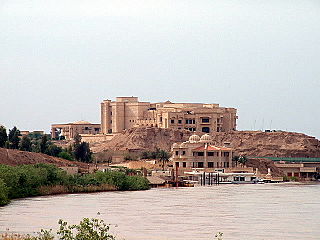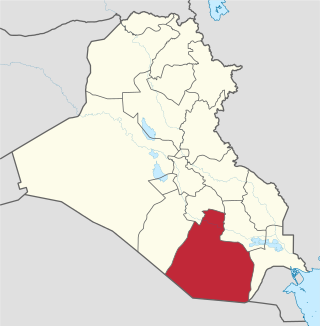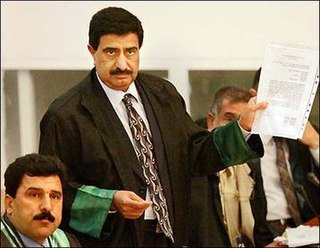Related Research Articles

Iraq is a country in Western Asia that largely corresponds with the territory of ancient Mesopotamia. The history of Mesopotamia extends from the Lower Paleolithic period until the establishment of the Caliphate in the late 7th century AD, after which the region came to be known as Iraq. Encompassed within Iraqi territory is the ancient land of Sumer, which came into being between 6000 and 5000 BC during the Neolithic Ubaid period of Mesopotamian history, and is widely considered the oldest civilization in recorded history. It is also the historic center of the Akkadian, Neo-Sumerian, Babylonian, Neo-Assyrian, and Neo-Babylonian empires, a succession of local ruling dynasties that reigned over Mesopotamia and various other regions of the Ancient Near East during the Bronze and Iron Ages.

The Culture of Iraq or The Culture of Mesopotamia is one of the world's oldest cultural histories and is considered one of the most influential cultures in the world. The region between the Tigris and Euphrates rivers, historically known as Mesopotamia, is often referred to as the Cradle of civilisation. Mesopotamian legacy went on to influence and shape the civilizations of the Old World in different ways such as inventing writing system, mathematics, law, astrology and many more. Iraq is home to diverse ethnic groups who have contributed to the wide spectrum of the Iraqi Culture. The country is known for its poets، architects، painters and sculptors who are among the best in the region, some of them being world-class. The country has one of the longest written traditions in the world including architecture, literature, music, dance, painting, weaving, pottery, calligraphy, stonemasonry and metalworking.

Tikrit is a city in Iraq, located 140 kilometres (87 mi) northwest of Baghdad and 220 kilometres (140 mi) southeast of Mosul on the Tigris River. It is the administrative center of the Saladin Governorate. As of 2012, it had a population of approximately 160,000.

Muthanna Governorate or Al Muthanna Province, is a province in Iraq, named after the 7th-century Arab general al-Muthanna ibn Haritha. It is in the south of the country, bordering Saudi Arabia and Kuwait. Its capital is the city of Samawah.
The Arameans, or Aramaeans, were an ancient Semitic-speaking people in the Near East that was first recorded in historical sources from the late 12th century BC. The Aramean homeland, sometimes known as the land of Aram, encompassed central regions of modern Syria.

After the 2003 invasion of Iraq, evidence began to emerge of failed attempts by the Iraqi government to bring the conflict to a peaceful resolution.
Tamuz may refer to:

Tammuz, or Tamuz, is the tenth month of the civil year and the fourth month of the ecclesiastical year on the Hebrew calendar, and the modern Assyrian calendar. It is a month of 29 days, which occurs on the Gregorian calendar around June–July.

The history of the Jews in Iraq is documented from the time of the Babylonian captivity c. 586 BCE. Iraqi Jews constitute one of the world's oldest and most historically significant Jewish communities.
Hebrew astronomy refers to any astronomy written in Hebrew or by Hebrew speakers, or translated into Hebrew, or written by Jews in Judeo-Arabic. It includes a range of genres from the earliest astronomy and cosmology contained in the Bible, mainly the Tanakh, to Jewish religious works like the Talmud and very technical works.
The military history of Iraq, due to a rich archaeological record, is one of the longest in written human history. The region of Iraq, which used to be Mesopotamia, has been referred to as the "cradle of civilization", and wars of conquest have been recorded in this region as far back as the third millennium BC. Because of its geopolitical dominance and ideology based in world domination, the Neo-Assyrian Empire is by many researchers regarded to have been the first world empire in history. The area possesses strategic value, initially for the rich, fertile agricultural region in the Mesopotamian plain, and more recently for large petroleum deposits and access to the oil-rich Persian Gulf. The present territory of Iraq lacks significant strategic barriers, making it difficult to defend against foreign invasion.

Iraqis are people who originate from the country of Iraq. Iraq is a multiethnic society, which means that it is home to people of many ethnic origins, and there is no correlation between one's stock and their Iraqi identity.

Khamis al-Obeidi was a lawyer defending Saddam Hussein and Barzan Ibrahim al-Tikriti, from the time the former leader's trial began in Baghdad on October 19, 2005, until his assassination. He was a Sunni Muslim, was married and had three children.
The Arabic names of the months of the Gregorian calendar are usually phonetic Arabic pronunciations of the corresponding month names used in European languages. An exception is the Syriac calendar used in Iraq and the Levant, whose month names are inherited via Classical Arabic from the Babylonian and Hebrew lunisolar calendars and correspond to roughly the same time of year.


Dumuzid or Dumuzi or Tammuz, known to the Sumerians as Dumuzid the Shepherd and to the Canaanites as Adon, is an ancient Mesopotamian and Levantine deity associated with agriculture and shepherds, who was also the first and primary consort of the goddess Inanna. In Sumerian mythology, Dumuzid's sister was Geshtinanna, the goddess of agriculture, fertility, and dream interpretation. In the Sumerian King List, Dumuzid is listed as an antediluvian king of the city of Bad-tibira and also an early king of the city of Uruk.

Iran–Iraq relations are the diplomatic and foreign relations between the two sovereign states of Iran and Iraq.
The Democratic July 14 Movement was a front of Iraqi political forces, a broad unity opposing Ba'athist rule over Iraq. It emerged through the cooperation between the Iraqi Communist Party-Central Command leader Najim Mahmud, Colonel Salim al-Fakhri and others. The name 'July 14' referred to the July 14 Revolution of 1958. Al-Fakhri had been an important associate of Abd al-Karim Qasim and had been proposed as Prime Minister by the plotters of the failed Ar-Rashid revolt. The movement claimed to represent the genuine legacy of July 14, 1958 from which, according to the organization, Qasim and his military associates had deviated from.
Several calendars have been used in pre-Islamic Arabia. Inscriptions of the ancient South Arabian calendars reveal the use of a number of local calendars. At least some of these South Arabian calendars followed the lunisolar system. For Central Arabia, especially Mecca, there is a lack of epigraphic evidence, but details are found in the writings of Muslim authors of the Abbasid era. Some historians maintain that the pre-Islamic calendar used in Central Arabia was a purely lunar calendar similar to the modern Islamic calendar. Others concur that the pre-Islamic calendar was originally a lunar calendar, but suggest that about 200 years before the Hijra it was transformed into a lunisolar calendar, which had an intercalary month added from time to time to keep the pilgrimage within the season of the year when merchandise was most abundant.

The Nabataean Agriculture, also written The Nabatean Agriculture, is a 10th-century text on agronomy by Ibn Wahshiyya. It contains information on plants and agriculture, as well as on magic and astrology. It was frequently cited by later Arabic writers on these topics.